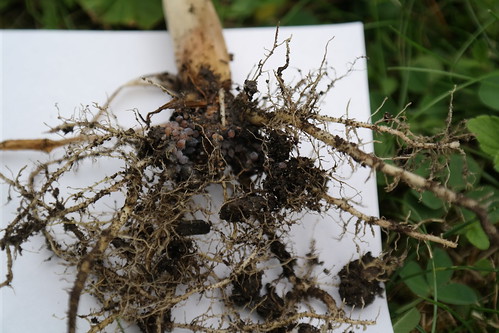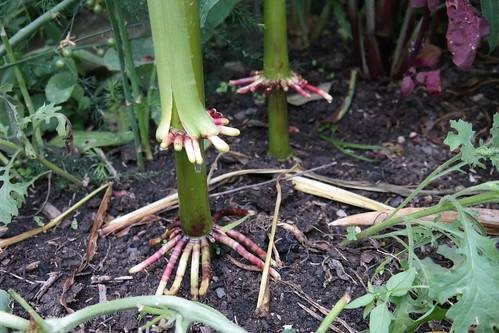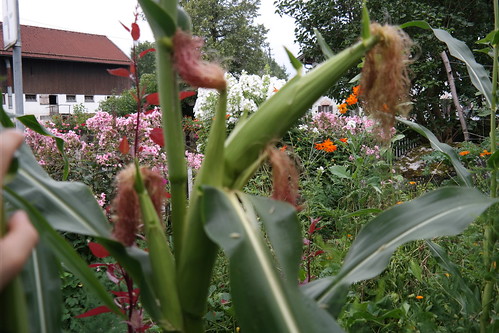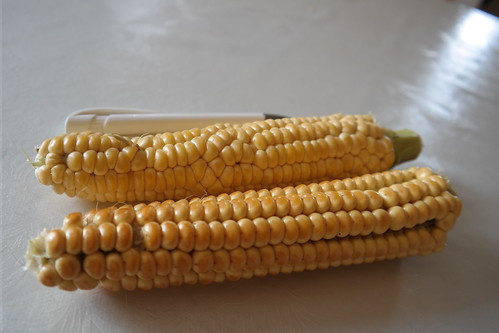andi
gopher

Posts: 7 
|
Post by andi on Jul 24, 2017 3:09:01 GMT -5
Hi folks, Greetings from southern Germany. 700 m above sealevel, erratic weather, high rainfall. Growing corn around here is usually pretty lame. Its not like there`s not a lot of corn growing, but its only in huge fields, only about five different commercial hybrid dent varieties and all of it for silage fodder or biogas production. There is no ongoing tradition in growing corn for human consumption around here, although it used to be a staple until about 100 years ago. This tradition consisted of mostly yellow flint varieties (4 t0 7 feet tall), but they are mostly gone forever. Some of them were perserved in seedbanks. The varieties I grow are: - magic manna flour corn (carol deppe) - cascade ruby gold flint corn(carol deppe) - longfellow flint corn - 3 old varieties from a seedbank (i think flint): i got only 10 seeds per var., those had terrible viability and i suspect inbreeding depression, because the tassels have comparatively little pollen The flour corn was the earliest to flower; i detasseled it as soon as the earliest flint started to shed pollen. The flints i let interbreed to overcome inbreeding depression from bad and to little seed. My main goal this season is to learn as much as possible about growing corn small scale with manual labour only. And as there is noone around here who could teach me, I am going to pester you guys with my problems  Question 1: I had some stunted plants and as I ripped them out I learned there is something called root lice. Never had to do with those before in my gardening endeavours... They look like this:  SAM_3161 SAM_3161 by afghani nurmat, auf Flickr Does anyone of you know an easy way to get rid of them? Question 2: I took a closer look at the ripped out plants to learn more about corn physiology and I found this:  SAM_3159 SAM_3159 by afghani nurmat, auf Flickr It is the unripe female inflorescence of one of the plants an it looks to me like it would give a branched cob? Is that a common thing? Question 3: Some plants have air roots from above ground internodes. I suppose I should have hilled them up. There is some kind of goo dripping from them. Is that normal?  SAM_3164 SAM_3164 by afghani nurmat, auf Flickr Question 4: Can you recommend any literature (online or print) about corn genetics or breeding techniques for corn. I really would love some info about what traits are dominant and recessive, how to select for varieties with solid coloured ears after doing crosses and stuff like that .... That`s it for today. I already thank you for your time and answers. Cheers, andi |
|
|
|
Post by philagardener on Jul 24, 2017 5:41:21 GMT -5
Hi andi , Welcome! Glad to hear about your corn project, and that you have been able to get some of Carol Deppe's varieties! Have you had your soil tested? There could be a lot of reasons the plants aren't doing well, and sometimes sickly plants can be a magnet for pests and diseases. That ear (#2) is strange - looks like the core of the cob didn't develop properly. It will be interesting to see if you have that problem with others, either on the same plant or others. The "air roots" #3 are called prop roots and they will grow out on their own to help hold the plant upright. It is a good characteristic, and prevents the plants from falling over (lodging) in wind and heavy rains. |
|
|
|
Post by walt on Jul 24, 2017 10:25:01 GMT -5
I have never seen root lice before, so I can't do more than tell you to google them.
Branched ears are common in some old South American varieties. They are not common in modern commercial varieties. The trait has been bred out because they are hard for harvest machines to deal with.
Air roots, or prop roots, do better if dirt is hilled up around them. Then they grow deeper and both feed the plant and suport it. Obviously, those that don't reach the ground won't help keep the plant upright.
Some varieties of corn grow lots of prop roots that quickly reach the soil and take hold. Other varieties have had prop roots bred out of them. Others, like yours, seem to be in between. I have never seen goo dripping from them, but I've never bent over and taken a good look at them. Are you sure it is not the morning dew? If the plants seem healthy, I wouldn't worry about it.
Welcome to the group.
|
|
|
|
Post by esoteric_agriculture on Jul 26, 2017 15:00:23 GMT -5
The " goo" dripping from the prop roots is a sugar based nutrient solution that the corn plant uses to feed microrhizal fungi. Perfectly normal.
|
|
andi
gopher

Posts: 7 
|
Post by andi on Jul 27, 2017 14:35:32 GMT -5
thank you all.
appreciate it!
|
|
Day
gardener
   When in doubt, grow it out.
When in doubt, grow it out.
Posts: 171
|
Post by Day on Aug 4, 2017 20:26:11 GMT -5
Hey andi ! I'm new to the forums as well. Welcome! While I can't offer much help on the first three questions (that hasn't already been answered) I can refer you to the following link regarding question #4. alanbishop.proboards.com/thread/8128/gmo-corn-genetics-pictures?page=1It's a 2014-2015 thread on Homegrown Goodness that is absolutely chock full of useful info. It's long, 15 pages, but is an absolutely amazing dialogue between the users regarding corn and corn genetics. Since you're growing several of Carol Deppe's varieties, I'll assume you're familiar with her books as well -- all fantastic resources. She's also part of the above thread, and provides very in depth and valuable insight on corn genetics. I truly can't recommend this thread enough if you're looking to gather knowledge about breeding corn. |
|
andi
gopher

Posts: 7 
|
Post by andi on Aug 8, 2017 9:49:42 GMT -5
Hey Day  That really is an awesome thread. How could I have missed that? Thank you. Carol Deppe`s books I do have (they are indeed the reason I went to the trouble to procure her varieties) and I love them and recommend them to anyone. And here is another candidate for the branched cob award:  branched cob 1 branched cob 1 by afghani nurmat, auf Flickr  branched cob 2 branched cob 2 by afghani nurmat, auf Flickr I wonder what that`ll turn into ... And while I`m at it: Here`s a little guy helping me with all the f... slugs (I hope he`ll bring along some friends next year...)  SAM_3199 SAM_3199 by afghani nurmat, auf Flickr Another thing I am wondering about is trying to convince my corn to flower earlier (for better isolation in time) and still be a full season corn. You guys think that`s doable or am I missing important side effects? So long, andi |
|
Day
gardener
   When in doubt, grow it out.
When in doubt, grow it out.
Posts: 171
|
Post by Day on Aug 8, 2017 11:14:48 GMT -5
andi - It's a very easy to miss thread, as it's quite old (in internet terms). I've been tempted to post and give it a 'bump,' but since Carol Deppe has been on hiatus from Homegrown Goodness (HG) for a while now, I wouldn't want to confuse anyone into thinking she's back and then tagging her with infinite² questions. I love that crazy corn! That's quite fun. Is it a pure strain, or a crossing from previous years? I've got an obsession with rogues, sports and weirdos, so this corn makes me happy  Convincing corn to tassel/silk earlier is a loaded question. If the corn is a daylength sensitive type, such as many imported from South American, there are a few tricks you can employ, such as planting in partial afternoon shade (to limit light hours and mimic the daylength at which the corn would normally begin tasseling/silking) or putting the plant under water stress. However, these do not guarantee success -- and can often have detrimental side effects, such as leggy plants, lodging, and dyssynchronous tasseling/silking. I've been fortunate to have luck, timing, and the shade of a large tree on my side when encouraging my South American corn to tassel early. However, I have serious dyssynchronous tasseling/silking, with only one plant thinking about forming an ear this early. The rest have tasseled, but show no sign of ear formation. A few are not fooled at all, and are still patiently waiting more appropriate daylight hours to begin any sort of reproduction. For me, though, this was a success - I intended to cross the Andean corn with other varieties, not breed purebred ears. So I simply used the Andean pollen and crossed it with the silks of other mothers, which I'd fortunately planted at the correct time for an overlap. If the corn variety is not day-length sensitive, or only mildly so, I do not know of a 100% 'safe and effective' method of encouraging early tasseling/silking (except to save seed from plants that do so and replant over several generations, creating your own early strain). As mentioned before, stressing a plant with too little water or overcrowding it can sometimes push the plant into hardcore survival mode, encouraging it to reproduce swiftly before it meets an untimely demise. But the side effects can be unpredictable, and it may not even be successful. You may end up with early tassels and no silks, or plants that produce meager ears, lodge, or even a complete loss of crop. Or it could work perfectly. The art of science! So apart from growing a short season variety or working to improve the variety yourself, I can't think of a 'get out of jail free' way to ensure early tasseling/silking without the potential for highly negative side effects. That said, I am by no means a certified corn expert - I speak only from my own experience combined with knowledge gained from books, articles, etc. I'd be very interested to hear insights from other HG corn folks!
|
|
|
|
Post by RpR on Aug 8, 2017 22:23:26 GMT -5
Andi:
I have been growing corn , for the sake of doing it now for several decades; sadly I have never had or been dedicated to do the cross breeding experiments many here do.
I have grown a goodly number of open pollinated dent and flour types experimenting with spacing of stalks, rows and plots to see how yield is affected and how much crossing goes on.
I would some years when I had more time, put in up to nine different types, plus one or two sweet corn types, in plots that were from eight to twelve feet approx. square.
They were close to each other, three to four feet with maturity differences being a big influence on reducing crossing.
I am in Minn. where 25 below Fahrenheit is common with growing weather lasting from ninety to one hundred and fifty days. The long ones are not common and you have to risk seeds rotting in cold ground by planting very early.
On rare, very rare occasions, the season has lasted from April to October; and then due to cold and wet, on occasion ninety days was being optimistic, due to seed rotting in the ground.
There were a few dry years when without constant watering or irrigation, fields were a total loss by mid July.
During the years I pushed it and by the grace of God weather cooperated, I have succeeded in getting 150 day corn to produce cobs but that was between years of simple failure to annoying failure such as finding out corn from the South West of the U.S. has brittle stalks. I.e. it it lodges when you try to stand it up it snaps off like a stick.
For the corns with air roots you can hill up or plant the corn in trenches that makes hilling simply filling in the trench.
I have spaced my corn from less than four inches to twelve inches. DO NOT do the very close spacing as even if the corn come up thick, you will get the equivalent of very, very tall grass. Stalks with very few cobbs but if you have reason to make silage,that would be ideal.
For your silage corns, if you can get some open pollinated or non-gmo hybrids, growing corn that is twelve to fifteen feet high is fascinating as is having cobs that are out of reach for a six foot man.
The fat squirrels in my home town are glad I do not save much for next years crop.
Back when I was putting a lot of effort and money into my corn plots I found out using mulch, for corn slices of small rectangular straw or hay bales between stalk and covering rows, GREATLY improved yield and reduced problems with weeds.
By this I mean when you look at the plot corn on the ground all you see is hay or straw. Weeds that come up in the gasp are easy to pull.
I generally slice,I use an old butcher knife but you can also just use your fingers, off slabs from one to two inches thick and lay it in the rows while also cutting the slabs into strips to put in between the individual stalks.
Old meadow hay works best.
I do not put toxic chemicals on my corn plants unless I have a serious problem but with your root problems it is best you put in your soil what ever is available in your area to deal with that quickly rather than wait and get miserable.
For corn rust I used Serenade, Sonata will work also, with fantastic results. For corn worms I would use pesticides on occasion just so it did not get worse.
I have good natural soil but keep it producing by putting a few yards of sheep manure on every x number of years.
Weeds I usually pull by hand but those that spread by rhizomes I spot spray by hand .
|
|
andi
gopher

Posts: 7 
|
Post by andi on Aug 20, 2017 6:44:50 GMT -5
hello again, today I harvested two ears of flint corn, because their husks were already damaged at the top (I just had to take a peek a few days ago) and our local ant population was pretty fast at figuring out they could just mine the starch. Also, I still have to learn how to determine, when harvest time has come. On pictures from Oregon or the American Midwest corn plants at harvest time always look very dried up and brown. I don`t think this is going to happen here at all, since we have several inches of rain every month, especially in summertime. I have never seen a dried up corn plant before the first severe frost (usually end of oktober and sometimes even as late as january) and I don`t want that to happen to my crop. here`s a picture  The ear in the background is supposed to be longfellow. On all the pictures of longfellow I have seen so far it had kind of pencil cobs with what I thought was eight rows. This one has ten rows and not what I would call a pencil cob. Any thoughts on that? (I got those seeds from a large seedbank ...) And I`m not sure if you can see this fine, but the same cob has some anthers sticking out on top and between some kernels. Is this some kind of hermaphrodite thing? If yes, I suppose I should cull this one or even the whole plant it was on, because hermaphrodism would promote severe inbreeding, right? Is this a common thing I have to look out for? Cheers, Andi |
|
|
|
Post by reed on Aug 21, 2017 3:53:05 GMT -5
I think those are fine looking ears of corn and I wouldn't worry at all about the anthers on that one ear. It isn't the norm here to have a lot of rain while ears are maturing but it can be extremely humid which is almost as bad as far as encouraging mold and the like. I try to compensate by growing short season varieties and I like to select for thinner ears with fewer rows of kernels. I think that helps with dry down. Seed is mature sooner than one might think but I feel the longer they can stay on the plant the better. I speculate that it makes for stronger seed with better storage life and more robust sprouting. Generally I like to at the very least see the silks completely dry and preferably some dry on the husks as well. Often times I will loosen the soil and pull up plants and stick them in pots to finish up. They don't need much soil or anything just a little leaves or weeds packed around the roots to keep a little moisture in and water them once in a while till ears have fully matured and dried. You can cut most of the stalk above the ears off to make them easier to handle.
I also grow small patches and counter inbreeding by crossing as many kinds as I can. In first couple seasons I did a lot of detasseling to insure crosses. It looks to me like you are on the right track, just need to replant some of your own seeds along with some new varieties if you can get them.
|
|
|
|
Post by walt on Aug 21, 2017 11:40:12 GMT -5
Anthers in the ears might be fertile if they are near the open end of the ear. Further in, I think it is too moist for the anthers to mature pollen.
My only complaint about anthers in the ears is that I like clean ears for eating.
|
|
|
|
Post by 12540dumont on Aug 21, 2017 19:19:46 GMT -5
Harvesting for earlier seed: Save the seeds from the bottom of the bean plants. For Corn: Save the top seeds from the corn itself for earlier plants next year.
So, I take my 100 ears from 100 different plants. Almost all of my corn yields 2-4 ears. I do not let them field dry, but pull the husks back and braid them and hang them in the barn. If I leave them in the field, the birds get at them. Especially Carol's corn, which doesn't have a lot of husk. Anyway, I shuck the top 1/3 of the corn and set that aside for early seed. I mix the seed from ALL 100 ears. Then I take the middles, which are the most robust and set those seeds aside for main season planting. Finally, the bottom 1/3 I husk and set aside for eating. Do NOT pick too early.
After I've mixed my seed, I set aside 1 pint canning jar for early and 1 pint canning jar for mid season. And put them in the freezer. (I eat or give away the rest). By consistently replanting the same corn the early corn will give you corn 2-4 weeks earlier than the middles. And by planting both the early and the middle, if one ripens early, you're still only crossing with the same variety. Using this method, you can start to do things like rogue out plants that are "too tall" or "too short". I rogue out plants that do give 2 ears. And if you have a bad year altogether, you can mix a couple of pints from previous years together. I never end up using the whole pint when I plant. What's left over is my insurance.
I've grown all of Carol's corn and posted about it somewhere in these corn threads. Read everything that Dar Jones wrote, and you'll have corn down.
|
|
|
|
Post by RpR on Aug 21, 2017 22:51:20 GMT -5
Main tricks to growing corn, soil quality, weed control, spacing, variety and fertilizing.
Your cobs look fine.
Unless you have extreme amounts of rain, that should not be much of a problem.
Here in Minn. hot and humid summer weather is not uncommon in recent years.
It is best to let the silk dry then you can do a s Dumont says and hang them in a barn or shed I do this often when I want to get the stalks out of the garden and do not want to wait for the crop to dry in the more normal manner or it I have very long maturity corn planted late in sprin.
Some farmers up here who do not want to spend money on drying corn simply let it in the field all winter to dry and pick in the spring.
|
|
|
|
Post by steve1 on Oct 24, 2018 6:46:48 GMT -5
Hi Andi, that goop on the aerial roots caught my attention. Quite possibly that it's a nitrogen fixing trait as outlined in a recent thread. My theory is it only expresses in soils that are N deficient, in the same way that pea rhizobia only fix N in soils that are N deficient.
I've seen the anthers off the female infloresence when the weather is cool at maturity, ie very late autumn here.
Hope that helps,
Steve
|
|

 SAM_3161 by afghani nurmat, auf Flickr
SAM_3161 by afghani nurmat, auf Flickr SAM_3159 by afghani nurmat, auf Flickr
SAM_3159 by afghani nurmat, auf Flickr SAM_3164 by afghani nurmat, auf Flickr
SAM_3164 by afghani nurmat, auf Flickr
 SAM_3161 by afghani nurmat, auf Flickr
SAM_3161 by afghani nurmat, auf Flickr SAM_3159 by afghani nurmat, auf Flickr
SAM_3159 by afghani nurmat, auf Flickr SAM_3164 by afghani nurmat, auf Flickr
SAM_3164 by afghani nurmat, auf Flickr





